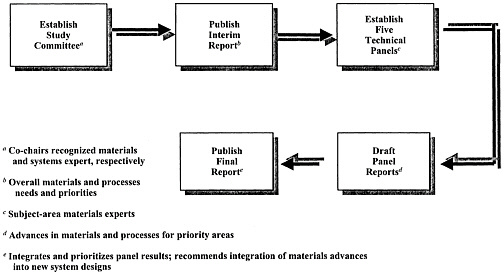1
Introduction
The U.S. Department of Defense (DOD), through the Defense Science and Technology Reliance Group Subarea for Materials and Processes, requested that the National Materials Advisory Board (NMAB) of the National Research Council conduct a study to identify and prioritize critical materials and processing research and development (R&D) to meet twenty-first-century defense needs. The Committee on Materials Research for Defense After Next was established to investigate investments in R&D required to meet both intermediate (up to 2020) and long-term (beyond 2020) DOD needs. The committee’s focus is on revolutionary materials concepts that would provide an advantage to U.S. forces in weapons logistics, deployment, and cost.
STUDY PLAN AND METHODOLOGY
The NMAB has undertaken a three-year study entitled “Materials Research for Defense After Next.” The overall methodology for the study is shown in Figure 1-1 . The initial phase, which began in December 1999 and is now complete, is documented in this interim report. In this phase the committee (13 scientists and engineers) met with technical representatives of the military services and DOD agencies, directors of service laboratories, and managers of DOD agencies (see Appendix A for information about committee members and Appendix B for meeting agendas). The objective of these meetings was to learn firsthand DOD’s ideas about current and future systems, logistics, and long-term costs (DOD, 1999a). The committee also learned the status of current R&D supported by DOD (Crowson, 2000; Schwartz, 2000; DOD, 1999a), the U.S. Department of Energy (Gottschall, 2000), and the National Science Foundation (Weber, 2000). The committee’s investigation was not exhaustive but provided a context for organizing subsequent meetings. The committee then met with materials experts from industry, academia, and national laboratories to determine research that could be brought to fruition in the 20-year to 30-year time frame specified for this study. At a subsequent meeting, the committee analyzed the data gathered and drafted this interim report.
The next phase of the study will begin with the establishment of five technical panels to explore in depth new opportunities in a given area of materials research and relate them to DOD needs. The relationship must be clear in principle, but not necessarily detailed because many of these concepts are still in their infancy. The mindset of the committee (and the reader) should be optimistic expectation. The question to be answered is what the impact of successful R&D, in a given area, will be on future defense systems. The next question (which also applies to more developed technologies already identified by DOD) is how their application can be accelerated to meet DOD needs.
The committee identified five technical areas for these detailed studies: structural and multifunctional materials; energy and power materials; electronic and photonic materials; functional organic and hybrid materials; and bio-derived and bio-inspired materials. The organization of the panels by function will encourage technical experts to participate, which will be crucial to their success. Members must also include systems thinkers and manufacturing experts. Each panel will attempt to quantify the impact of new materials and processes and identify technical road blocks to their development.
This interim report includes a discussion of DOD systems needs in Chapter 2 and research priorities for materials and processes in Chapter 3 . Chapter 4 contains a plan to relate the R&D priorities to the materials science challenges. As a whole, this report defines the general direction of future R&D.
To facilitate the management of the technical panels, members of the study committee would provide the chair of each panel (and perhaps also the co-chair and panel members, as appropriate), subject to NRC approval. NMAB liaisons to the study committee will also serve as liaisons to the technical panels (see Appendix C ).
STATEMENT OF TASK FOR THE OVERALL STUDY
The committee was asked to accomplish the following tasks:
-
review DOD planning documents and input from DOD systems-development experts to identify long-term technical requirements for weapons system development and support
-
develop materials needs and overall materials priorities based on DOD requirements
-
establish and guide approximately five study panels to investigate priority areas and recommend specific research opportunities
-
integrate and prioritize the research opportunities recommended by the study panels
-
recommend means of integrating materials and processing advances into new system designs.
ANTICIPATED STUDY RESULTS
The anticipated results when this study is completed are:
-
definition of the materials needs of DOD in the next 20 years and identification of investment priorities and opportunities for materials and processing R&D most likely to lead to the fulfillment of those needs
-
analysis of specific research opportunities that match the identified needs of DOD
-
integration and prioritization of the research opportunities
-
recommendation of methods best suited for integrating materials and processing advances into new systems designs to accelerate the development and deployment of new war-fighting equipment





